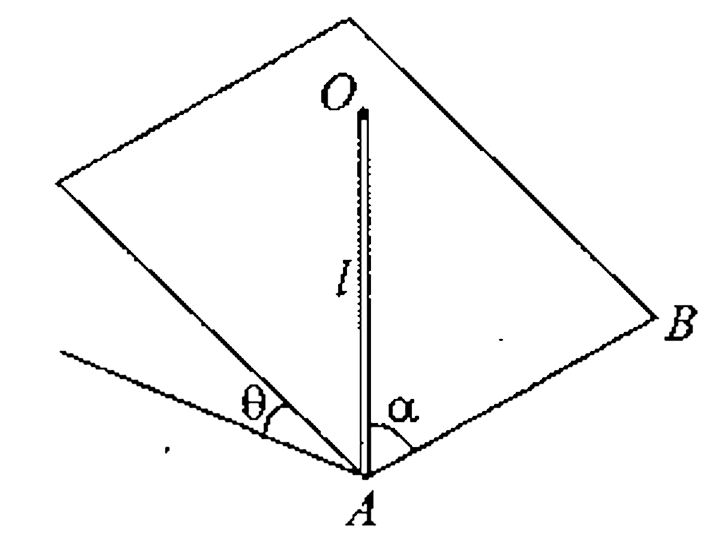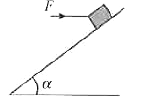A small object is kept on a groove on rough incline plane of inclination θ. Groove wakes an angle α as shown in diagram. μ coefficient of friction. Which of the following is correct

Normal force by incline plane. N=mgcosθ
Normal force by incline is N=mg√cos2θ+sin2θsin2α
maximum frictional force that can develop is fmax=μmgcosθ
If μ=0 then acceleration of blocks is gsinθcosα
The correct Answer is:B, D
N1=mgcosθ perpendicular to the plane
N2=mgsinθsinα
N2 is in the plane of incline perpendicular to groove.
N=√N21+N22 If μ=0
Net force along groove. mgsinθcosα. Hence acceleration is gsinθcosα.
Topper's Solved these Questions
- BOOK - NARAYNACHAPTER - FRICTIONEXERCISE - Passage type of questions6videos
FRICTION
- BOOK - NARAYNACHAPTER - FRICTIONEXERCISE - Integer type questions14videos
FRICTION
- BOOK - NARAYNACHAPTER - FRICTIONEXERCISE - Passage type of questions I6videos
FRICTION
- BOOK - NARAYNACHAPTER - COLLISIONEXERCISE - Level-II (H.W)54videos
COLLISION
- BOOK - NARAYNACHAPTER - GRAVITATIONEXERCISE - EXERCISE -IV40videos
GRAVITATION
Similar Questions
A block is kept on a inclined plane of inclination q of length l. The velocity of particle at the bottom of inclined is (the coefficient of friction is μ
View SolutionThere is an inclined surface of inclination θ. A smooth groove is cut into it forming an angle α with AB as shown in figure. A steel ball is free to slide a long the groove. If the ball is released from the point O. Find the speed when it comes to A.
 View Solution
View Solution
Knowledge Check
- Question 1 - Select One or More
A small on rough inclined groove on rough inclined plane of inclination θ. Groove makes an angle α as shwon in Fig . 7.173 , μ is the coefficient of friction . Which of the following is correct ?
 ANormal force by inclined plane . N = mg cos θBNormal force by inclined is N=mg√cos2θ+sin2θsin2αCMaximum frictional force that can develop is fmax=μmgcosθDIf μ=0 then acceleration of block is g sin θcosα
ANormal force by inclined plane . N = mg cos θBNormal force by inclined is N=mg√cos2θ+sin2θsin2αCMaximum frictional force that can develop is fmax=μmgcosθDIf μ=0 then acceleration of block is g sin θcosα - Question 2 - Select One
A block is kept on an inclined plane of inclination θ of length l. the velocity of particle at the bottom of inclined is (the coefficient of friction is μ)
A√2gl(μcosθ−sinθ)B√2gl(sinθ−μcosθ)C√2gl(sinθ+μcosθ)D√2gl(cosθ+μsinθ) - Question 3 - Select One
An object is placed on the surface of a smooth inclined plane of inclination θ. It takes time t to reach the bottom. If the same object is allowed to slide down a rough inclined plane of inclination θ, it takes time nt to reach the bottom where n is a number greater than 1. The coefficient of friction μ is given by:-
Aμ=tanθ(1−1n2)Bμ=cotθ(1−1n2)Cμ=tanθ√1−1n2Dμ=cotθ√1−1n2
A block of mass m slides down a rough inclined plane of inclination θ with horizontal with zero initial velocity. The coefficient of friction between the block and the plane is μ with θ>tan−1(μ). Rate of work done by the force of friction at time t is
View SolutionAn object is placed on the surface of a smooth inclined plane of inclination . It takes time t to reach the bottom of the inclined plane. If the same object is allowed to slide down rough inclined plane of same inclination , it takes time nt to reach the bottom where n is a number greater than 1. The coefficient of friction is given by -
View SolutionA block of mass m is placed on a rough inclined plane of inclination θ kept on the floor of the lift. The coefficient of friction between the block and the inclined plane is μ. With what acceleration will the block slide down the inclined plane when the lift falls freely ?
View SolutionA block of mass m in the equilib rium on a rough inclined plane with inclination α and coefficient of friction as shown in the figure (μ<tanα). A force F is applied on the block which makes an angle θ with the horizontal as shown in diagram.
 View Solution
View SolutionA hollow sphere of mass m and radius R is rolling downdard on a rough inclined plane of inclination θ. If the coefficient of friction between the hollow sphere and incline is μ, then
View Solution

